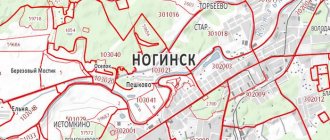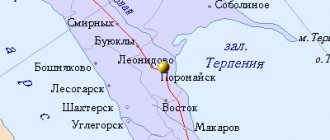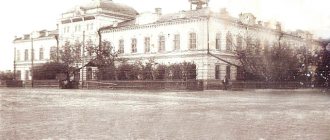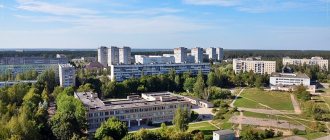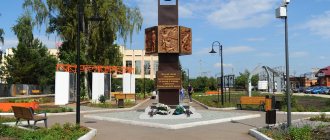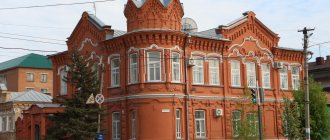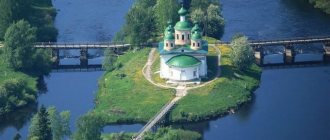Content
- 1 Russia 1.1 Arkhangelsk region
- 1.2 Bashkortostan
- 1.3 Vladimir region
- 1.4 Vologda region
- 1.5 Ivanovo region
- 1.6 Kaliningrad region
- 1.7 Kaluga region
- 1.8 Kostroma region
- 1.9 Krasnodar region
- 1.10 Kurgan region
- 1.11 Leningrad region
- 1.12 Lipetsk region
- 1.13 Mari El
- 1.14 Moscow
- 1.15 Moscow region
- 1.16 Nizhny Novgorod region
- 1.17 Novgorod region
- 1.18 Perm region
- 1.19 Pskov region
- 1.20 Ryazan region
- 1.21 Saratov region
- 1.22 Sakhalin region
- 1.23 Smolensk region
- 1.24 Tver region
- 1.25 Tula region
- 1.26 Khabarovsk Territory
- 1.27 Chelyabinsk region
- 1.28 Yaroslavl region
Voskresenskoye
— names of settlements:
Russia[ | ]
Arkhangelsk region[ | ]
- Voskresenskoye is a village in Velsky district.
Bashkortostan[ | ]
- Voskresenskoye is a village in Zilairsky district.
- Voskresenskoye is a village in Kugarchinsky district.
- Voskresenskoye is a village in Meleuzovsky district.
Vladimir region[ | ]
- Voskresenskoye is a village in Aleksandrovsky district.
- Voskresenskoye is a village in Kameshkovsky District.
- Voskresenskoye is a village in the Kolchuginsky district.
- Voskresenskoye is a village in Yuryev-Polsky district.
Vologda region[ | ]
- Voskresenskoye is a village in Babushkinsky district.
- Voskresenskoye is a village in Vozhegodsky district.
- Voskresenskoye is a village in the Kubensky rural settlement of the Vologda region.
- Voskresenskoye is a village in the Sosnovskoye rural settlement of the Vologda region.
- Voskresenskoye is a village in Gryazovets district.
- Voskresenskoye is a village in the Voskresensky rural settlement of Cherepovets district.
- Voskresenskoye is a village in the Yugsky rural settlement of Cherepovets district.
Ivanovo region[ | ]
- Voskresenskoye is a village in Ilyinsky district.
- Voskresenskoye is a village in Kineshma district.
- Voskresenskoye is a village in Lezhnevsky district.
- Voskresenskoye is a village in the Rodnikovsky district.
- Voskresenskoye is a village in Savinsky district.
Kaliningrad region[ | ]
- Voskresenskoye is a village in the Nesterovsky district.
Kaluga region[ | ]
- Voskresenskoye is a village in Ferzikovsky district.
- Voskresenskoye is a disappeared village in the Iznoskovsky district.
Kostroma region[ | ]
- Voskresenskoye is a village in the Antropovsky district.
- Voskresenskoye is a village in Galichsky district.
- Voskresenskoye is a village in Nerekhta district.
- Voskresenskoye is a village in Ostrovsky district.
Krasnodar region[ | ]
- Voskresenskoye is a village in Otradnensky district.
Kurgan region[ | ]
- Voskresenskoye is a village in Polovinsky district.
- Voskresenskoye
- until 1935, the name of the village of Kirovo in the Mishkinsky district.
Leningrad region[ | ]
- Voskresenskoye is a village in the Volkhov region.
- Voskresenskoye is a village in the Gatchina region.
Lipetsk region[ | ]
- Voskresenskoye is a village in the Voskresensky rural settlement of Dankovsky district.
- Voskresenskoye is a village in the Oktyabrsky rural settlement of Dankovsky district.
- Voskresenskoye is a village in Chaplyginsky district.
Mari El[ | ]
- Voskresenskoye is a village in Sovetsky District.
Moscow[ | ]
- Voskresenskoye is a historical village that became part of Moscow (Presnensky district).
Moscow region[ | ]
- Voskresenskoye is a village in the Noginsk region.
- Voskresenskoye is a village in Ramensky district.
- Voskresenskoye is a village in Ruza district.
- Voskresenskoye is a village in the Shakhovskaya urban district.
Nizhny Novgorod region[ | ]
- Voskresenskoye is an urban-type settlement, the administrative center of the Voskresensky district.
- Voskresenskoye is a village in Sergachsky district.
- Voskresenskoye is a village in Tonshaevsky district.
Novgorod region[ | ]
- Voskresenskoye is a village in Marevsky district.
- Voskresenskoye is a village in Pestovsky district.
Perm region[ | ]
- Voskresenskoye is a village in Uinsky district.
Pskov region[ | ]
- Voskresenskoye is a village in the Gdovsky district.
- Voskresenskoye is a village in the Pskov region.
- Voskresenskoye is a village in Pushkinogorsky district.
Ryazan region[ | ]
- Voskresenskoye is a village in Miloslavsky district.
Saratov region[ | ]
- Voskresenskoye is a village, the administrative center of Voskresensky district.
Sakhalin region[ | ]
- Voskresenskoye is a village in Anivsky district.
Smolensk region[ | ]
- Voskresenskoye
is the name of the village of Dneprovskoye in the Novoduginsky district until 1935.
Tver region[ | ]
- Voskresenskoye is a village in Andreapolsky district.
- Voskresenskoye is a village in the Pogorelsky rural settlement of Zubtsovsky district. OKATO: 28218828022.
- Voskresenskoye is a village in the Pogorelsky rural settlement of Zubtsovsky district. OKATO: 28218828040.
- Voskresenskoye is a village in the Kalininsky district.
- Voskresenskoye is a village in the Kalyazinsky district.
- Voskresenskoye is a village in the Likhoslavl district.
- Voskresenskoye is a village in the Molokovsky district.
- Voskresenskoye is a village in Sonkovsky district.
- Voskresenskoye
- until 1925, the name of the village of Krasnaya Gora in the Kalininsky district.
Tula region[ | ]
- Voskresenskoye is a village in Venevsky district.
- Voskresenskoye is a village in the Dubensky district.
- Voskresenskoye is a village in Odoevsky district.
- Voskresenskoye is a village in Chernsky district.
Khabarovsk Territory[ | ]
- Voskresenskoye is a village in Ulchsky district.
Chelyabinsk region[ | ]
- Voskresenskoye is a village in Kasli district.
Yaroslavl region[ | ]
- Voskresenskoye is a village in Lyubimsky district.
- Voskresenskoye is a settlement in the Myshkinsky district.
- Voskresenskoye is a village in the Nekouzsky district, part of the Vereteyskoye rural settlement.
- Voskresenskoye is a village in the Nekouzsky district, part of the Oktyabrskoye rural settlement.
- Voskresenskoye is a village in Pereslavl district.
- Voskresenskoye is a village in Poshekhonsky district.
- Voskresenskoye is a village in the Uglich region.
- Voskresenskoye is a village in the Uglich region.
Voskresensky district
Education of the Voskresensky district
Until 1929, the Moscow province consisted of 17 districts. The border of Bronnitsky and Kolomna districts passed through the territory of modern Voskresensk. In accordance with the resolution of the Presidium of the All-Russian Central Executive Committee of January 14, 1929, the Moscow province and all counties were abolished, the territory of the former province was included in the Central Industrial Region, transformed on June 3, 1929 into the Moscow region.
In July 1929, by government decree, 10 districts and 144 districts were formed in the Moscow region, including Voskresensky. In August 1929, by decisions of local government congresses, district boundaries were established and local authorities were created. For almost 30 years, there were two independent districts - Vinogradovsky and Voskresensky, which on January 1, 1958 were united into one Voskresensky district.
Lands of the region in the 10th–17th centuries
In the 10th century, in the interfluve of the Volga and Oka and the Moscow River basin, including the lands that are today part of the Voskresensky district, from the banks of the Dnieper, the Slavic tribes of the Radimichi and Vyatichi began to penetrate and settle in these places. To this day, burial mounds from the Vyatichsky burials have been preserved here.
In the 12th–13th centuries, the lands of the modern Voskresensky municipal district were the border lands of the Vladimir-Suzdal principality, an area of impenetrable forests. Along the Nerskaya River (in those days Merska), the left tributary of the Moscow River, ran the border between the Ryazan and Vladimir-Suzdal principalities.
The lands of the present-day Voskresensky district are mentioned in the spiritual charter of Moscow Prince Ivan I (Kalita) in the 1st half of the 14th century: “He gave his son Semyon a great theme: Mozhaisk, Kolomna with all the Kolomna volosts, Gorodenka, Medynya, Pesochna, Pokhryane, Ust- Merska, Broshevaya, Gvozdna...” The last five volosts, centuries later, partially or completely became part of the modern Voskresensky district.
In the Scribe Book of Kolomna Uyezd for 1577–1578. Many villages of the region are mentioned for the first time, including the village of Voskresenskoye, which later gave its name to the center of the region. The village was part of the ancient Ust-Merskaya volost; it was divided into four parts, one of which was a graveyard (a place for collecting taxes) that belonged to Ivan the Terrible. Here there was a wooden Church of the Resurrection of Christ, mentioned in the same scribe book and which gave the name to the village.
The Voskresensk lands are connected by centuries-old family ties with Kolomna. Villages in the Kolomna district experienced enemy invasions, civil strife, and the formation of Orthodoxy and Russian statehood. On these lands, squads of the Great Moscow Princes and sovereigns Dmitry Ivanovich (Donskoy), Ivan III Vasilyevich, Ivan IV the Terrible gathered. Many Voskresensk toponyms preserve the memory of those historical events - Five Crosses, Semislavka, Ratchino, Ratmirovo, Berkino, Gorodishche, Argunovo, Saburovo, Marchugi and others.
The territory of the Voskresensky district in the 18th–19th centuries
By decree of Peter I, signed on December 18, 1708, all lands of the Russian state were divided into 8 provinces. On February 3, 1709, Peter I approved the painting of the cities of the Moscow province. This date is considered to be the day of the formation of the Moscow province. The central lands were assigned to the province, including 39 cities - about 50 counties in total. Along with the lands near Moscow, the province included the territories of modern Tula, Ryazan, Vladimir, Ivanovo, most of Yaroslavl, partly Kostroma and Kaluga regions. It was difficult to manage such a large territory, so the next reform of 1719 introduced intermediate territorial units - provinces, of which 9 were formed in the Moscow province. The neighboring lands near Moscow became part of the Moscow province. In other provinces, administration was carried out by voivodes, but the Moscow province was governed directly by the governor.
By decree of Catherine the Second of 1781, Bronnitsy district was formed from the northern territories of Kolomensky district, the center of which was the former village of Bronnitsy, transformed according to the Decree into a district town. Part of the villages of the future Voskresensky district (Konstantinovo, Marchugi, Novlyanskoye, etc.) were transferred from Kolomensky district to Bronnitsky.
In 1860, Emperor Alexander II approved the project for the construction of the Moscow-Saratov railway through Ryazan and Morshansk. Already during construction, it was decided to limit the construction of the road to Ryazan. At first, there were 6 stations along the entire route, including Voskresensk, which was located at the same distance from Bronnitsy, Kolomna and Yegoryevsk. Soon, a village of the same name, Voskresensk, was formed near the station. The newly formed settlement and station became an economic center for the surrounding villages and villages.
In 1864, in the town of Sadki (Khorlovo), the merchant I. Demin founded the Sadkovskaya Manufactory Partnership. In 1870, in the village of Fedotovo, merchant V. Katsepov opened a dyeing factory with an office for distributing yarn. In 1883, the Katsepovs founded the same production in the village of Lopatino, and a year before that, in 1882, they built a paper-weaving factory in the village of Baranovskoye. In 1898, a brick factory was founded near the village of Krivyakino.
Territory of the district at the beginning of the 20th century
In 1913, industrialist B. Serikov built a cement plant on the banks of the Moscow River, located between the villages of Psarevo (Pavlovo) and Kolyberevo.
According to the 1926 census, the population of the station village of Voskresensk was slightly more than 600 people. The village gradually turned into the administrative and cultural center of the Kolyberevskaya volost. In 1928, work began on the construction of a slate factory (No. 1) near the Semislavka River.
In April 1929, the first 5-year plan for the development of the national economy was adopted, providing for the construction of 518 new industrial enterprises throughout the country, including chemical ones. Among such chemical facilities, it was planned to build a group of enterprises on the basis of the Yegoryevskoye phosphorite deposit, which later became known as the Voskresensky Chemical Plant named after V. Kuibyshev.
Voskresensky district
In August 1929, the Voskresensky district was formed as part of the Moscow region, which included the Kolyberevskaya volost, parts of the Nepetsinskaya and Myachkovskaya volosts of the Kolomna district, as well as Chaplyginskaya (Chaplyzhenskaya), Spasskaya and part of the territory of the Usmerskaya volost of the Bronnitsky district. In fact, immediately after the formation of the district, the construction of a chemical plant began, which became the “first-born of the first five-year plan.” Among the first builders were residents of the surrounding villages and villages - Neverovo, Krivyakino, Lopatino, Fedotovo and others. Artels of carpenters, masons and other specialists from neighboring regions also took part in the construction - about 4 thousand people in total.
In 1930, the first 4-story brick house was laid (today it is building 16 on Oktyabrskaya Street). Following him, 2 more houses were laid on the same street (Nos. 12 and 14) and a 5-story building on Sovetskaya Street. Construction of residential buildings begins in the village of Krivyakino (today these are houses No. 15 and 17 on Pionerskaya Street). School building No. 1, the building of the district executive committee and the post office were built.
At the same time, construction of the chemical plant continued. On January 22, 1931, the phosphate rock workshop produces the first tons of products. This day is considered the birthday of the enterprise. In the same year, construction of the largest cement plant began on the banks of the Semislavka River. In 1934, slate plant No. 2 began operating, and the first products were produced by the asbestos pipe plant.
In 1937, three plants - asbestos pipe and slate plants No. 1 and No. 2 - were merged into the Krasny Stroitel plant. Large factory villages are being developed near each enterprise. Soon, all these villages, together with the settlements of Berkino, Kolyberevo, Suvorovo, Five Krestov, Pavlovo, formed a single working village of Kolyberevo. By 1939, about 12,000 people already lived here.
In 1941–1945, during the Great Patriotic War, 29 thousand residents of the Voskresensky district stood up to defend the country. Of these, about 10 thousand did not return to their homes from the battlefields. In 1941–1942, Voskresensk was a front-line city and was bombed. The construction of defensive structures was carried out along the left bank of the Moscow River. Enterprises in the region produced military products.
In 1954, the working settlement of Kolyberevo became part of the city of Voskresensk. The length of Voskresensk from north to south along the Moscow River and the Moscow-Ryazan railway was about 16 km, and its area was 25 square meters. km. On January 1, 1958, the Vinogradovsky district became part of the Voskresensky district. In 1962, the village of Fosforitny was transferred to the Voskresensky district from Yegoryevsky. As a result, the area of the Voskresensky district within the new boundaries was 810 square meters. km.
In the 1960s–1980s. A new wave of migration arose, which was caused, first of all, by the fact that the new production facilities of the Voskresensky Chemical Plant and the Moscow Mining and Chemical Plant were declared All-Union Komsomol shock construction projects.
